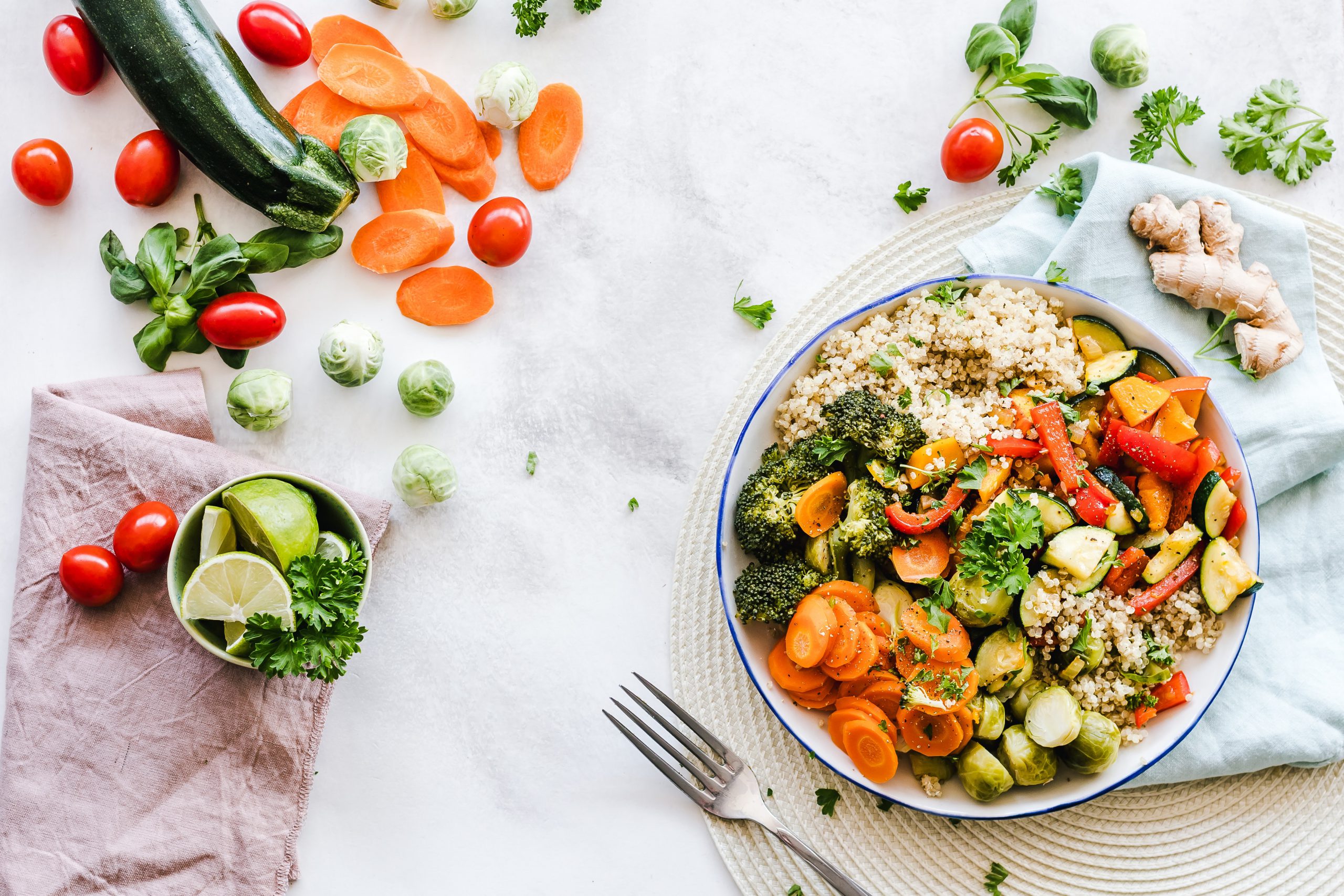Intermittent Fasting has become all the rage, but why is that, and is there truth in how it works? After years of hearing that calories in vs. calories out are the only equation you need or that six small meals per day are the best metabolism-revving plan of action, intermittent Fasting has come with new science that explains why it could be the best answer. Here is your easy-to-follow Intermittent Fasting Guide for newbies.
What is Intermittent Fasting?

Intermittent Fasting, also called “time-restricted feeding,” is the practice of eating food within a specified “restricted” period daily. One of the most common approaches to intermittent Fasting that you may have heard of includes a 16-hour fasting period of no food intake, followed by an 8-hour feeding period.
What does this look like? It could be eating meals between 10 am and 6 pm and Fasting between 7 pm – 10 am.
Let’s look at some other techniques:
Alternate Day Fasting: 36-hours fast, 12-hours feed. You eat every other day and can eat anything during your feeding period.
Meal Skipping: Skip meals once or twice a week while encouraged to eat unprocessed foods (this may not lead to weight loss if that is your goal, but it can help overall health.)
Eat, Stop, Eat: 24-hour fast, 1-2 times per week; you eat as usual the rest of the time.
Leangains: 16-hour fast, 8-hour feed. You’re encouraged to eat foods high in protein, cycle carbohydrates, and exercise in a fasted state.
Warrior Diet: 20-hour fast, 4-hour feed. You can eat small amounts of specifically recommended foods during your fast and then feed during the other 4 hours.
Extended Fast: I consider extended fasting anything over 48 hours. It is common for many individuals to do 3, 5, and 7-day fasts. This type of Fasting is for experienced fasters only and is to be done under the supervision of a doctor or trained fasting coach.
The Easy To Follow Intermittent Fasting Guide For Newbies

Fasting vs. Grazing to Lose Weight
The fitness industry standard was eating three meals and two snacks every 2-3 hours. Now, we need to consider not only the consistency of foods throughout the day but also the portion sizes of those foods.
To understand how we lose and gain weight, we must know how the body uses energy and how food releases the hormone insulin.
Different foods stimulate different amounts of insulin release, except for pure fat, which causes no insulin release. Insulin levels change based on what type of food you intake.
Accordingly, to lose weight, the equation fat = (Calories in) – (Calories out) isn’t always correct. We talk about why weight loss isn’t as simple as this and why the way the body consumes energy is what matters.
Where Does the Body Get Energy
The body can get energy from two different places:
- Food
- Stored food energy (glycogen in the liver or body fat)
This is critical: You can only get energy from one or the other, but not both at the same time.
That means: You either burn fat or store it. You can’t do both at the same time.
If you eat a lot of food, you store food energy which = body fat. When you fast, you burn food energy (body fat) by default.
Insulin Is Key
The critical regulator is your hormone insulin, which tells our body to store fat (glucose) or burn it for energy. It keeps your blood sugar levels from becoming too high or too low.
The grazing technique of eating six times per day keeps your insulin levels high and gives you energy directly from the foods you eat, but never tapping into body fat stores.
Food types play a huge factor in insulin levels, and they can even sense when you eat carbohydrates vs. protein. Refined foods, mainly carbs such as a bagel, cause the highest insulin release, creating an insulin spike. This means the body needs to burn more from the bagel than it would need to burn from a piece of lean meat before it ever starts burning the fat stores in your body.
The calorie reduction technique of making a typical intake of 2000 calories down to 1500 in hopes of losing weight does not work long term because it doesn’t consider insulin (your body’s fat/sugar regulator). You may lose weight initially, but it gradually slows your metabolism due to decreased calories. Weight loss starts to plateau, and chances are you will regain the lost weight, if not even more.
The key to successful long-term weight loss is not reducing calories.
With insulin-regulating, whether your body is burning food energy or storing food energy (body fat), the key to accessing your body fat stores is to reduce overall insulin levels. You must let your body go into the ‘fasted’ state to switch on the burning of body fat stores.
Benefits Of Intermittent Fasting

Intermittent Fasting has many benefits, and you may not experience all the benefits the first time. Fasting is like exercise; you need to start small and learn what works for your body and how your body responds. As time passes, you get better at it and enjoy more benefits.
Generally, it takes about 1-2 weeks of intermittent Fasting before the body responds, your hunger reduces, and you adapt to your new eating schedule. Stick to a smaller fasting window first; don’t stress over it.
Improves Relationship with Food
Many of us eat mindlessly and struggle with food and sugar cravings. Fasting helps us realize that these cravings are sometimes mental and emotional and manageable.
Reduces Decision Fatigue
You eat 2 – 3 meals daily and have much less to worry about where your next meal comes from as you preplan your meals. This leads to healthier food choices without leaving it up to what you can find during feeding times.
Stimulates Fat Burning
Fasting creates the ideal environment for fat burning as your insulin levels stabilize, and the body uses fat as fuel and produces ketones.
Improves Energy Levels
You notice more natural energy when the body uses ketones for fuel and increases norepinephrine in response to the fast.
Stimulates Cellular Autophagy and Reduces Inflammation
Autophagy is part of the natural immune system, where the body breaks down old, damaged parts of cells and abnormally developing cells to recycle them for energy. It then uses these raw materials to build new and healthier cells or to repair damaged organelles within the cells. In essence: It’s the body’s way of house cleaning. This aids in reducing inflammation in areas that have become unhealthy or unbalanced.
Improves Insulin Sensitivity
Fasting has been shown to help resolve insulin resistance. When the body becomes resistant to insulin, insulin and glucose build up in the blood and create inflammation. Intermittent Fasting allows your body to take a break. Since there is no food to digest and your body uses up all its sugar stores, insulin levels begin to drop, allowing the body to re-sensitize to insulin again.
Improves Clarity
Fasting has also been used throughout history as a way to elevate consciousness in many religions. Additionally, Fasting can help us tune out emotional urges and tune into our intuition, which helps us make better decisions in life.
Important Intermittent Fasting Tips

- Working Out – Take it easy the first few days and weeks and focus more on walking outside than intense workouts.
- Don’t undereat during feeding times. You will most likely eat 2 larger meals until you’re 80% full and not stuffed.
- Stay consistent with your chosen intermittent fasting window until your body has gotten used to it physically and mentally.
- Superhydrate at least 8-16 oz of water or herbal tea upon waking to deter constipation, reduce hunger, and stabilize adrenals.
- Add Himalayan sea salt to your water. Doing this, along with adding organic broths and a magnesium supplement, can all assist in restoring lost electrolytes and minerals. See my full blog post on why you need to boost magnesium intake in midlife.
- Go outside and get sunshine. This helps to reduce stress, enhance Vitamin D production, and stimulate fat burning by ketosis.
Who Shouldn’t Fast
Although Fasting is a great lifestyle choice, it does not fit all.
- People with disordered eating are at high risk of not healing physically, mentally, and emotionally from it.
- Pregnant women shouldn’t fast, especially in the 2nd-3rd trimesters, due to the baby’s rapid growth
- Type 1 diabetics who cannot produce insulin should only fast under a doctor’s supervision.
- High-level athletes with intense training regimens need much higher calories and a larger eating window.
How to Integrate Intermittent Fasting into Your Own Life
Now that you know all the incredible benefits Intermittent Fasting can have on your life and body, I recommend pairing it slowly with other low-impact workouts and new habits. Take it easy at first, and keep it simple by going outside for walks, reconfiguring your relationship with food, and gently starting a strength training routine, such as Pilates. We are starting another series of the Pursue Your Spark Blueprint soon.
🌟Pursue Your Spark Blueprint: Dive into our 8-week online group course, specially crafted for women in midlife. It’s more than just a program—it’s a life-changer. Learn to eat better, move more, and unlock boundless energy. With my guidance, you’ll step into a life of strength and confidence. Join me to transform your health and step into your most confident self. Ready for a change? Apply here.

Heike, I have never had the benefits of intermittent fasting explained so simply and comprehensively. I am an intermittent, intermittent faster! In other words not committed. I do not plan and obviously that is key. You are an excellent example of it working… Thank you
Hilda, thanks for stopping by and yes, it takes planning but at least you’re trying it out and it may stick at some point.
This post is super helpful! I’ve been pondering this and didn’t realize all of the benefits. I’m glad you provided this comprehensive (but not overwhelming) information!
Lisa, thank you for stopping by and I am glad my post was so helpful.
Pingback: Answers To The Most Asked Questions About The 4 Week Lean Out Program
Comments are closed.